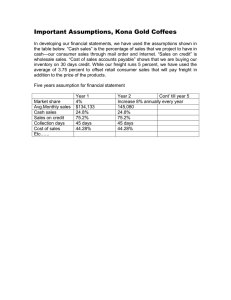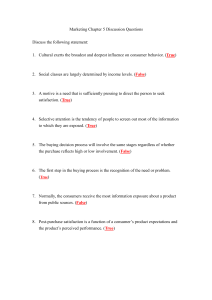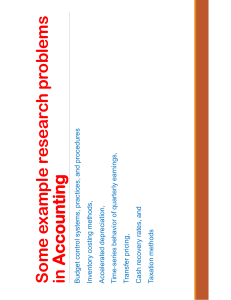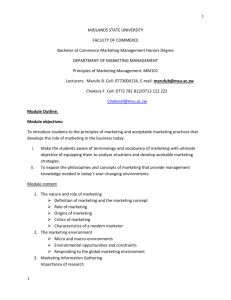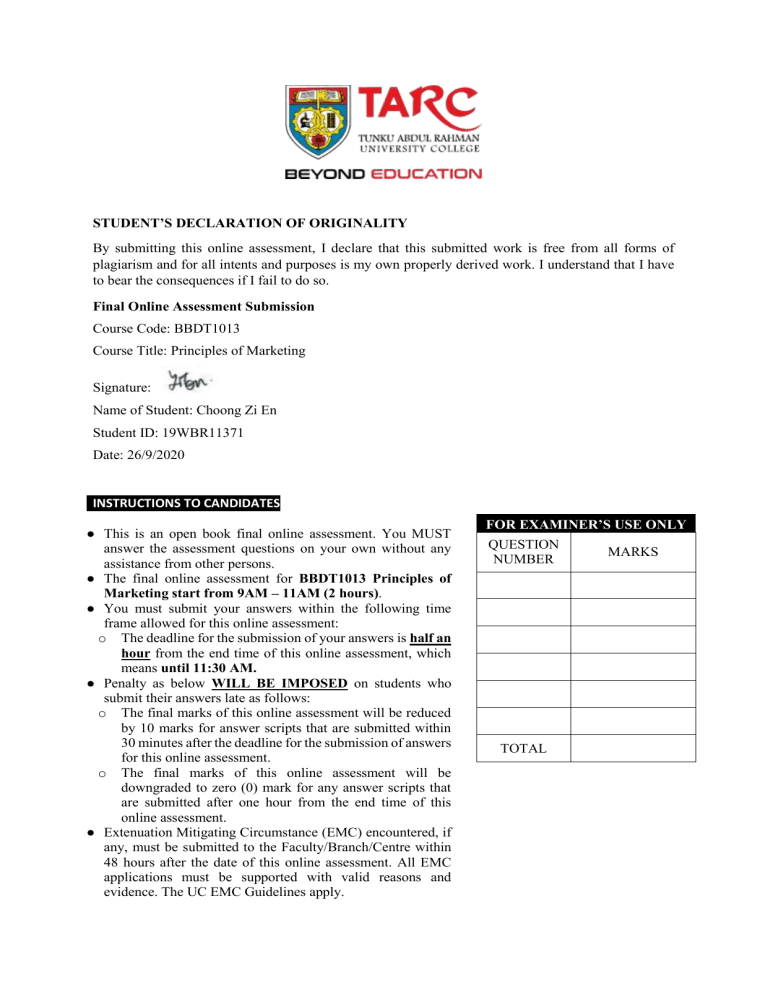
STUDENT’S DECLARATION OF ORIGINALITY By submitting this online assessment, I declare that this submitted work is free from all forms of plagiarism and for all intents and purposes is my own properly derived work. I understand that I have to bear the consequences if I fail to do so. Final Online Assessment Submission Course Code: BBDT1013 Course Title: Principles of Marketing Signature: Name of Student: Choong Zi En Student ID: 19WBR11371 Date: 26/9/2020 INSTRUCTIONS TO CANDIDATES ● This is an open book final online assessment. You MUST answer the assessment questions on your own without any assistance from other persons. ● The final online assessment for BBDT1013 Principles of Marketing start from 9AM – 11AM (2 hours). ● You must submit your answers within the following time frame allowed for this online assessment: o The deadline for the submission of your answers is half an hour from the end time of this online assessment, which means until 11:30 AM. ● Penalty as below WILL BE IMPOSED on students who submit their answers late as follows: o The final marks of this online assessment will be reduced by 10 marks for answer scripts that are submitted within 30 minutes after the deadline for the submission of answers for this online assessment. o The final marks of this online assessment will be downgraded to zero (0) mark for any answer scripts that are submitted after one hour from the end time of this online assessment. ● Extenuation Mitigating Circumstance (EMC) encountered, if any, must be submitted to the Faculty/Branch/Centre within 48 hours after the date of this online assessment. All EMC applications must be supported with valid reasons and evidence. The UC EMC Guidelines apply. FOR EXAMINER’S USE ONLY QUESTION NUMBER TOTAL MARKS Instructions to Candidates: ● ● Answer ALL FOUR (4) questions. The answers to be typed in font size 12pt, Times New Roman, 1.5 spacing and Justify the text alignment on A4 size papers. NOTE: The amount of space given in the box does not indicate a limit to the length of your answer. The space would expand with the length of your answers. ANSWER: Question 1a) Based on the above, the positioning practised by Xpeed is product position, which is the way the product is defined by consumers on important attributes.While, positioning consists of arranging for a market offering to occupy a clear, distinctive and desirable place relative to competing products in the minds of target customers. Question 1b) The targeting strategy used by Xpeed is concentrated marketing. Concentrated marketing also called as niche marketing strategy. Instead of going after a small share of a large market, a firm goes after a large share of one or a few smaller segments or niches. It can market more effectively by fine-tuning its products, prices and programs to the needs of carefully defined segments. Question 1c) ● Geographic Segmentation. This refers to dividing the market into different geographical units such as nations, regions, states, countries, cities, neighbourhoods and climate. Based on the scenario, Xpeed produces its products in Malaysia. ● Demographic Segmentation. It divides the market into segments based on variables such as age, life-cycle, gender, income, occupation, education, religion, ethnicity and generation. For instance, Xpeed divides their products to the premium segment with premium standards and outstanding quality. ● Psychographic Segmentation. It divides buyers into different segments based on social class, lifestyle, and personality characteristics. For instance, Xpeed provides their products based on customer’s lifestyle and their long run interest in cars using biofuel technologies and sources. ● Behavioral Segmentation. This divides buyers into segments based on their knowledge, attitudes, uses or responses to a product. Xpeed divides their cars into segments according to the different benefits such as a smoother ride with improved safety biofuel technology that consumers seek from the products and determine to fulfill customers’ needs. Question 2a) There are 3 methods in intensity of market coverage which are intensive distribution, selective distribution, and exclusive distribution. ● Intensive distribution. This is ideal for producers of convenience products and common raw materials and it is a strategy in which they stock their products in as many outlets as possible. ● Selective distribution. This is the use of more than one but fewer than all of the intermediaries or outlets who are willing to carry a company’s products, suitable for shopping products. ● Exclusive distribution. This purposely limits the number of intermediaries handling their products. The producer gives only a limited number of dealers the exclusive right to distribute its products in their territories. For products purchased infrequently, consumed over a long time of period or requiring service and information like specialty products. Question 2b) There are four classification of consumer products, including convenience products, shopping products, specialty products, and unsought products. Convenience products are relatively inexpensive, frequently purchased items for which buyers exert minimal purchasing effort. They are no search required, available at many retailers, and usually low price points. Shopping products are the items for which buyers are willing to expend considerable effort in planning and making purchases. They require more extensive search, available substitute, and less frequent purchase. They have no brand loyalty, fewer retail outlets than convenience and lower inventory turnover. Specialty products are the items with unique characteristics that buyers are willing to expend considerable effort to obtain. They require extensive search, are generally higher price points, and have no ready substitute. Also, they have limited retail outlets, lower inventory turnover and high gross margins. Unsought products are products purchased to solve a sudden problem; products of which customers are unaware; and products that people do not necessarily think of buying. They no search, price not important, and purchase compelled. These products build trust with consumers prior to need, recognizable brand, and superior performance. Question 3a) The new product development process is idea generation, idea screening, concept development and testing, marketing strategy development, business analysis, product development, test marketing, and commercialization. A company is necessary to follow all the steps in developing a new product because the development of original products, product improvement, product modifications and new brands can be generated through the firm’s own product development efforts. Also, the product development process helps to avoid high risk of failure and provide new value to customers based on the product and price. Question 3b) The four types of geographic pricing strategies used by a company are : ● FOB - origin pricing. This refers to the goods that are placed on board a carrier and the customer pays the freight from the factory to the destination. ● Uniform - delivered pricing. This refers to the charges of the same price plus freight to all customers, regardless of their location. ● Zone pricing. This refers to the customers within a given zone paying a single total price, the more distant the zone, the higher the price. ● Basing-point pricing. This refers to the seller selects a city as a “basing point” and charges customers the freight cost from that city to the customer location, regardless which city the goods are actually shipped. From a company’s point of view, FOB-origin pricing is best because the seller earns the same amount for each sale of equivalent quantities. For instance, the buyer will bear all the freight costs and be responsible for carrying the goods from that port to their final destination. Hence, the seller does not need to pay any freight charges in this method and this is the greatest advantage of it. Question 4a) The types of joint venture strategies a company can use to enter a foreign market are : ● Licensing. This is when a firm enters into an agreement with a licensee in a foreign market. For a fee or loyalty, the licensee buys the right to use the company’s process, trademark, patent, trade secret, or other item of value. ● Contract manufacturing. This occurs when a firm contracts with manufacturers in the foreigh market to produce its product or provide its service. Benefits include faster startup, less risk, and the opportunity to form a partnership or to buy out the local manufacturer. ● Management contracting. This occurs when the domestic firm supplies management skill to a foreign company that supplies capital. The domestic firm is exporting management services rather than products. ● Joint ownership. This is when one company joins forces with foreig. investors to create a local business in which they share joint ownership and control. Joint ownership is sometimes required for economic or political reasons. Question 4b) Business market refers to the individuals or groups that purchase a specific kind of product for resale, direct use in producing other products, or use in general daily operations. The three major types of buying situations are straight rebuy, modified rebuy, and new task rebuy. ● Straight rebuy. The buyer reorders something without any modifications. ● Modified rebuy. The buyer wants to modify product specifications, prices, terms, or suppliers. ● New task rebuy. A company buying a product or service for the first time. Systems selling, or solutions selling, refers to buying a single packaged solution to a problem from a single seller. This can avoid the separate decisions involved in a complex buying situation.

